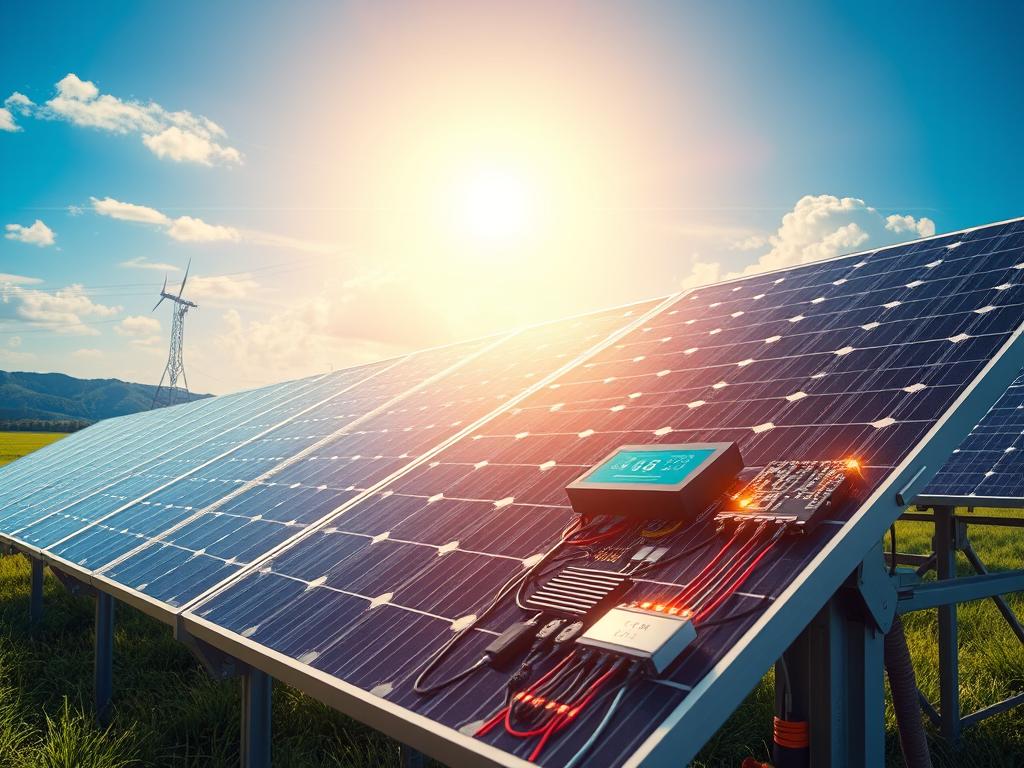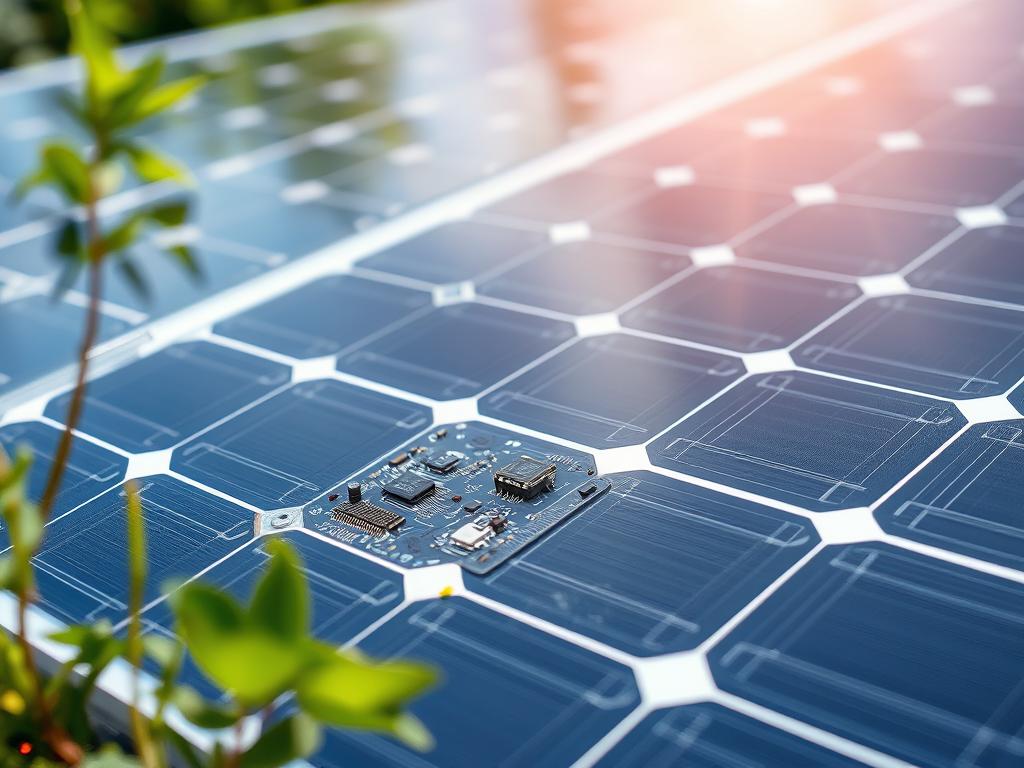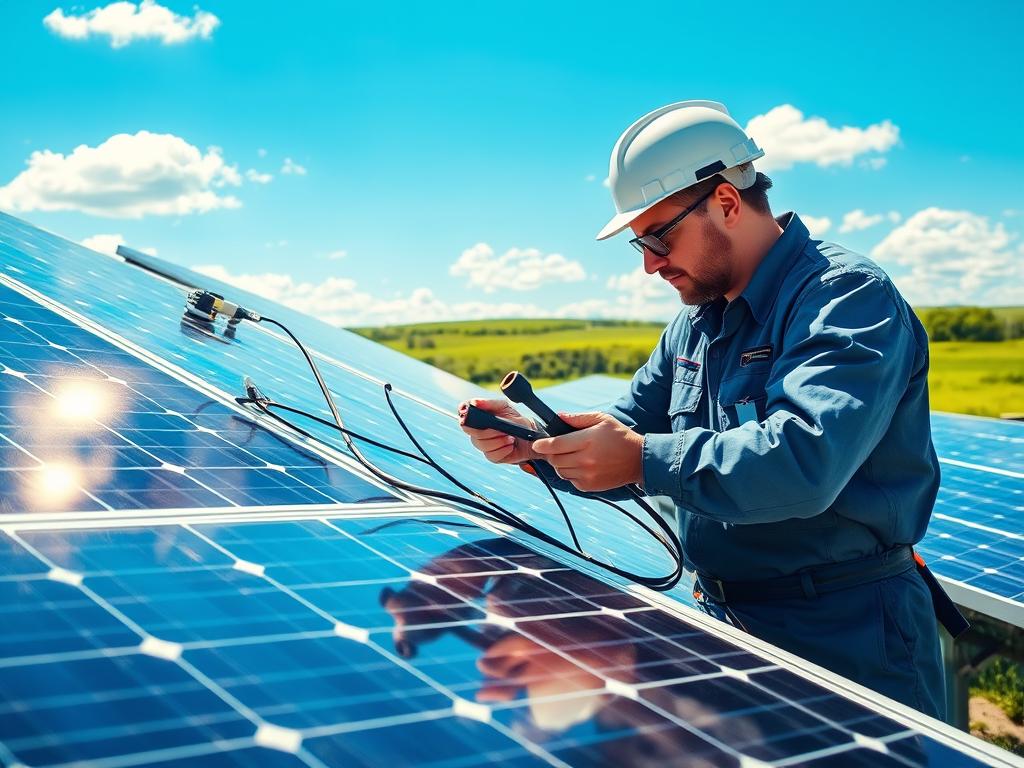Experts are working hard to make solar energy more efficient. They use transistors to improve how solar power is converted and managed. This technology helps engineers and tech fans get the most out of solar power, making systems work better.
Studies show that solar panels with the right transistors can be 20% more efficient. They also lose about 10% less energy when sending power. Plus, these systems catch 25% more energy when sunlight changes and are 30% more reliable than old setups.
This article will dive into how transistors are key for better solar energy systems. It’s packed with tips for those looking to make their solar systems more efficient.
Key Takeaways
- Transistors can increase energy efficiency by up to 20% in solar panels.
- Overall maintenance costs can be reduced by 15% with transistor use.
- Solar setups with transistors capture approximately 25% more energy during sunlight changes.
- Reliability increases by 30% in systems incorporating transistors compared to traditional designs.
- Optimized systems may exhibit an energy output boost of up to 15% during peak sunlight hours.
Understanding Solar Energy Systems
Solar energy systems turn sunlight into electricity. Knowing the parts of these systems boosts their performance. This section covers the key parts, like solar panels and inverters, and how they work together.
Components of Solar Energy Systems
The main parts of solar energy systems are:
- Solar Panels: These turn sunlight into electrical energy.
- Inverters: They change direct current (DC) from solar panels into alternating current (AC) for homes. In 2024, there are three types: string, micro, and hybrid inverters.
- Battery Storage: It stores extra energy for when the sun isn’t out.
- Mounting Structures: These hold solar panels in the best sunlight position.
Choosing the right solar panels and inverters is key for better efficiency. String inverters are often used in homes because they’re affordable and simple. Microinverters, like those from Enphase, work well in shaded areas or complex roofs, improving efficiency.
How Solar Panels Work
Solar panels work by turning sunlight into electricity. Here’s how:
- Photovoltaic Effect: This principle makes electricity in solar panels.
- Energy Conversion: How well a panel works depends on its ability to turn sunlight into electricity. New designs and tech keep improving this.
- System Performance: The right setup means less loss and more energy.
The connection between solar panel parts and system efficiency is vital. As tech gets better, we aim to make solar panels more efficient. This ensures we use the energy we produce well, offering a green solution.
| Component | Function | Advantages |
|---|---|---|
| Solar Panels | Convert sunlight into electricity | High impact on energy production |
| String Inverters | Convert DC to AC for household use | Cost-effective and easy to install |
| Microinverters | Optimize power output at individual panels | Better performance in shaded areas |
| Hybrid Inverters | Integrate solar power with battery storage | Energy flexibility and reliability |
The Role of Transistors in Solar Energy
Transistors are key in making solar energy work well. They help turn sunlight into electricity efficiently. Knowing about the different types of transistors used in solar energy helps us see how they improve system performance.
What Are Transistors?
Transistors act as electronic switches and amplifiers. In solar energy, they control and convert electricity from solar panels. IGBTs are a special type of transistor used in solar energy. They mix the best of two worlds, making solar systems more efficient and reliable.
Types of Transistors Used in Solar Applications
There are various transistors for different tasks in solar energy. Here’s a table showing some common types and their uses:
| Transistor Type | Application | Benefits |
|---|---|---|
| Bipolar Junction Transistors (BJTs) | Power amplification and switching | High current handling and stability |
| Field-Effect Transistors (FETs) | Switching adjustments for voltage control | Low power consumption and fast switching speed |
| Insulated Gate Bipolar Transistors (IGBTs) | Power conversion in solar inverters | High efficiency and thermal performance |
Benefits of Using Transistors
Transistors add great value to solar energy systems. They help in many ways:
- Improved energy conversion: New transistor tech makes solar inverters work better, turning DC to AC efficiently.
- Space efficiency: Their small size makes them easy to fit into systems, saving space.
- Cost-effectiveness: Advances in transistor tech, like IGBTs, cut costs while boosting energy output with MPPT algorithms.
Research to improve transistor performance is ongoing. It leads to smarter, cheaper solar energy solutions. For more on transistor tech, check out the latest advancements in smart power transistors.

Enhancing Efficiency with Transistor Technology
Transistor technology is key to making solar energy systems more efficient. It boosts the energy conversion rates, leading to more power from solar panels. Advanced transistors, especially those from gallium oxide, promise to change how solar energy systems work.
Improving Energy Conversion Rates
Transistors are essential for better energy conversion in solar systems. High bandgap materials, like gallium oxide, are making a big difference. Gallium oxide needs more energy to start conducting, which means solar systems can handle more power.
This leads to higher energy outputs from solar panels. It also keeps the systems lightweight.
Reducing Energy Losses
Transistors also help in reducing energy losses. Gallium oxide transistors can work well even at high temperatures without needing big cooling systems. This cuts down on thermal energy losses, making more solar energy usable.
These transistors are also tiny, just 5 micrometers wide. Their small size helps reduce energy losses in power distribution. This makes the whole system more efficient.
Case Studies: Transistor Applications in Solar Energy
Transistors are key to making solar energy systems more efficient. Real-world projects show how advanced transistor technologies work well. For example, the University at Buffalo’s research on gallium oxide transistors is exciting. They have a high breakdown voltage of 1,850 volts, showing great promise for solar energy.
Successful Implementations
Innovative projects show how transistors boost solar energy systems. They are crucial in managing power in photovoltaic systems. Choppers, like MOSFETs, help control current and power efficiently.
Changing chopper setups can cut down on losses and boost performance. Using PWM converters also helps get more power from solar panels. High-voltage transistors improve signal quality and system reliability. These examples highlight transistors’ role in renewable energy.
Lessons Learned from Real-World Applications
Many projects have taught us a lot about designing and running solar systems. It’s important to model chopper losses accurately. This helps predict how systems will perform under changing solar conditions.
For instance, the SUNPOWER photovoltaic panel SPR-315E-WHT-D shows good performance. Its peak power and efficiency match theoretical values. These findings help improve system performance and show the value of using transistors in solar energy.
Choosing the Right Transistor for Your System
Choosing the right transistor is key for solar energy systems to work well. You need to look at current rating, voltage rating, and power dissipation. Knowing these helps make the right choice for your system.
Factors to Consider in Selection
When picking a transistor, consider these important traits:
- Voltage Rating: This shows the max voltage a transistor can handle without failing.
- Current Rating: It’s crucial for the transistor to handle the needed current without overheating.
- Power Dissipation: This tells you how much power can be safely dissipated to avoid damage.
- Switching Speed: Fast-switching transistors are needed for quick responses in applications.
- Thermal Management: Good heat dissipation is key to keep efficiency and reliability up.
Comparing Different Transistor Types
Knowing about different transistor types helps in choosing the right one for your needs:
| Transistor Type | Advantages | Disadvantages | Common Applications |
|---|---|---|---|
| Bipolar Junction Transistor (BJT) | High current gain, simple construction | Higher power consumption, slow switching | Amplification, signal switching |
| Field-Effect Transistor (FET) | Low power loss, high input impedance | Susceptible to voltage spikes | Voltage regulation, digital circuits |
| MOSFET | Fast switching, low leakage current | Sensitive to static electricity | Used in low-power applications |
| Insulated Gate Bipolar Transistor (IGBT) | High efficiency, suitable for high voltages | Slower than MOSFETs | Used in automotive and renewable energy applications |
By looking at specific traits and trade-offs, engineers can find the best transistor for their projects. For example, GaN Systems’ GaN transistors boost power efficiency and shrink size in devices like the SolPad Home™ and SolPad Mobile™. This shows how important it is to choose the right transistor for today’s needs.
Integrating Transistors into Existing Systems
Adding transistors to current solar energy systems can boost performance without needing a full system change. By using advanced tech, we can make big improvements while solving issues of compatibility and stability.
Retrofitting Solutions
Upgrading existing systems with new transistor tech aims to make the most of what we already have. This means:
- Transparent transistors: Made by Xtreme Energetics, these transistors improve performance and keep things looking good.
- Integrated circuits: Oregon State University’s transparent circuits can greatly boost efficiency by fitting right in with what we already have.
- IGBT technology: Used in solar inverters, this tech ensures top-notch power conversion and grid syncing.
Challenges and Considerations
There are hurdles when adding new tech to old solar systems. These include:
- Compatibility: It’s key to make sure new parts work well with what’s already there to keep the system running smoothly.
- System stability: Any updates should not hurt the system’s reliability or performance.
- Installation and maintenance: You often need skilled people for installing and keeping these upgrades running right.

The Future of Transistors in Solar Energy
The world of solar energy is changing fast, thanks to new technologies. Transistors are key to making solar energy better and more powerful. New discoveries and improvements in transistors will change how we use solar power.
Emerging Technologies and Innovations
Transistors are getting smarter, with emerging solar technologies like gallium nitride (GaN) leading the charge. These transistors work better than old silicon ones. They lose less energy and work more efficiently, making solar energy more effective.
Quantum computing is also making big waves for solar transistors. It helps solve complex problems fast, making energy use better. This could lead to even more efficient solar systems in the future.
Predictions for Solar Industry Growth
The solar industry growth is speeding up, and advanced transistors are key. Experts say we’ll see more solar panels and better performance. New transistors can change and work more efficiently, beating old computers.
As transistors get better, so will solar panels. This will help solar energy become a big part of our daily lives. The solar industry is set for a big change, thanks to new transistor tech.
For more on transistor history and evolution, check out this resource. It covers important moments that shape today’s tech.
Environmental Impact of Efficient Solar Systems
Efficient solar systems are key to a greener future. They help reduce environmental harm. As we use up fossil fuels fast, turning to renewable energy is more important than ever.
Reduced Carbon Footprint
Solar energy is crucial for cutting down carbon emissions. Solar systems cut down CO2 emissions a lot. New designs, like CoolSiC inverter systems, make them even better.
In 2023, we added 510 GW of renewable power worldwide. Most of it, 75%, came from solar. This helps the planet and brings electricity to over 1.2 billion people without it.
Contribution to Renewable Energy Sources
More money is going into clean energy, showing a big change. Solar tech, like the AEM10941 solar lamp, brings light to dark places. In Cameroon, 80-90% of people still don’t have electricity.
Using solar power can greatly improve life in these areas. It’s also good for the planet. Solar tech is growing fast, expected to grow 20.9% each year until 2030.

| Statistic | Impact |
|---|---|
| 1.2 billion people lack access to electricity | Highlighting the need for efficient energy solutions |
| 510 GW of renewable power added globally in 2023 | Demonstrates the shift to renewable energy sources |
| 75% of new capacity from solar PV | Emphasizes solar power’s domination in renewable expansion |
| 80-90% of population in Cameroon without electricity | Calls attention to urgent electrification needs |
| CAGR of 20.9% for residential solar installations until 2030 | Indicates strong growth and adoption in the market |
Policy and Incentives for Solar Efficiency
The growth of solar energy in the U.S. gets a big boost from policies and government efforts. These efforts help make solar energy more common. The government is investing in solar technology to make it better and more efficient.
Government Initiatives
The U.S. Department of Energy has made big investments in solar. They’ve put $52 million into solar manufacturing and $30 million for grid tech. These moves aim to make solar energy more efficient and affordable.
Projects focus on improving solar parts, like recycling and new materials. The SunShot Initiative wants to make solar energy cheaper. You can learn more about these plans in this announcement.
Financial Incentives for Solar Installations
The government offers financial help for solar installations. This includes tax credits, rebates, and grants. These incentives help lower the cost of going solar.
The solar tax credit lets you deduct some costs from taxes. Local programs also offer special incentives. These help make solar energy more accessible and efficient.
| Incentive Type | Description | Potential Benefits |
|---|---|---|
| Federal Solar Tax Credit | Deductions on installation costs from federal taxes | Reduced tax burden and overall installation costs |
| State Rebates | Direct cash rebates for solar system installations | Immediate financial support to homeowners |
| Grants | Financial aid for specific solar projects | Boosts project feasibility and accessibility |
| Net Metering Policies | Credit system for excess energy produced | Offsets energy costs, enhancing savings |
Maintenance Best Practices for Solar Systems
Keeping solar energy systems in top shape is key to their long-term performance. It’s important to follow best practices for maintenance. This includes regular checks and upkeep to avoid problems. These steps help your system work better and save you money.
Regular Monitoring and Upgrades
Regular checks are the first step in good maintenance. This means looking over your system and tracking its performance. Important parts of regular checks include:
- Checking solar panels for damage or dirt.
- Looking at how much energy your system is making.
- Using the latest tech to watch how your system is doing.
Upgrades are also part of keeping things running smoothly. Adding new tech or software can make your system better. Good maintenance for solar systems means fixing small problems before they get big.
Importance of Preventative Maintenance
Preventative maintenance is all about stopping problems before they start. It involves following the rules set by the makers of your system. Some common tasks include:
- Using special cameras to find bad panels.
- Cleaning your panels to catch more sunlight.
- Checking electrical parts and moving parts to keep them working right.
There’s also a new way called predictive maintenance. It uses tech to guess when parts might break. This way, you can fix things before they cause big problems.

Putting together regular checks and upkeep is crucial for solar systems. By focusing on these, you can make sure your system works well. This means less downtime and more energy for you. For more on how transistor tech can improve performance, check out this link.
| Maintenance Type | Description |
|---|---|
| Preventative Maintenance | Routine tasks to prevent failures, including inspections and cleaning. |
| Corrective Maintenance | Actions taken to restore functionality after a failure, including diagnostics and repairs. |
| Predictive Maintenance | Condition-based maintenance using analytics to forecast equipment degradation. |
Cost Analysis: Investing in Efficient Systems
Understanding the financial side of solar energy systems is key to making smart choices. The cost analysis shows both the initial costs and the long-term savings from better efficiency. Investing in new tech, like high-frequency transistors, can save a lot of energy over time.
Upfront Costs vs. Long-Term Savings
Buying solar tech means paying for parts, installation, and setup. These costs can be high at first. But, studies show that the savings over time are usually more than the initial cost.
Using better components, like inverters and transistors, can cut down on electricity bills and upkeep. Many users see their investment pay off faster because of the system’s increased power and reliability.
Financial Viability of Upgraded Systems
Looking at the financial side of upgrades means checking a few things. This includes the parts available, like photovoltaic systems and inverters. Better availability means less downtime, which boosts productivity and saves money.
Research shows that using advanced materials and tech, like in the guide on high-frequency transistors for solar energy, brings more benefits over time. This makes a strong case for upgrading, with many seeing better costs and energy output.
Consumer Awareness and Education
Knowing about solar energy is key to using advanced solar tech. Homeowners who learn about solar systems can save money and use energy better. By making educational resources more available, we help more people understand and use new solar tech.
Resources for Homeowners
Homeowners can learn a lot about solar tech. There are many ways to get this knowledge:
- Workshops by local solar groups
- Online courses from experts
- Websites with info on solar tech benefits
- Community programs for saving energy
- Webinars on solar tech updates
The Role of Education in Technology Adoption
Learning about solar tech helps people use it more. When people know about the benefits of new tech, like transistors, they use it more. This is because:
- They understand how well systems work
- They feel sure about their choices
- They join in on green energy efforts
- They work with pros for installations

Learning helps people use new solar tech. When homeowners know what they’re doing, they make better choices. This leads to a cleaner, more sustainable world.
Conclusion: The Way Forward in Solar Energy
Transistors are key to making solar energy better and more efficient. They help solar systems work better and lose less energy. To keep solar energy growing, we need new ideas and more money to make systems work even better.
Summary of Key Points
Solar technology has come a long way since the 1950s. Now, solar panels are much more efficient, thanks to transistors. This is crucial for cutting down on carbon emissions and reaching our clean energy goals.
Call to Action for Industry Stakeholders
It’s time for the solar industry to step up. We need more research and better technology to fight climate change. Working together, we can make solar energy a big part of our future. For more on how technology has evolved, check out this link.


